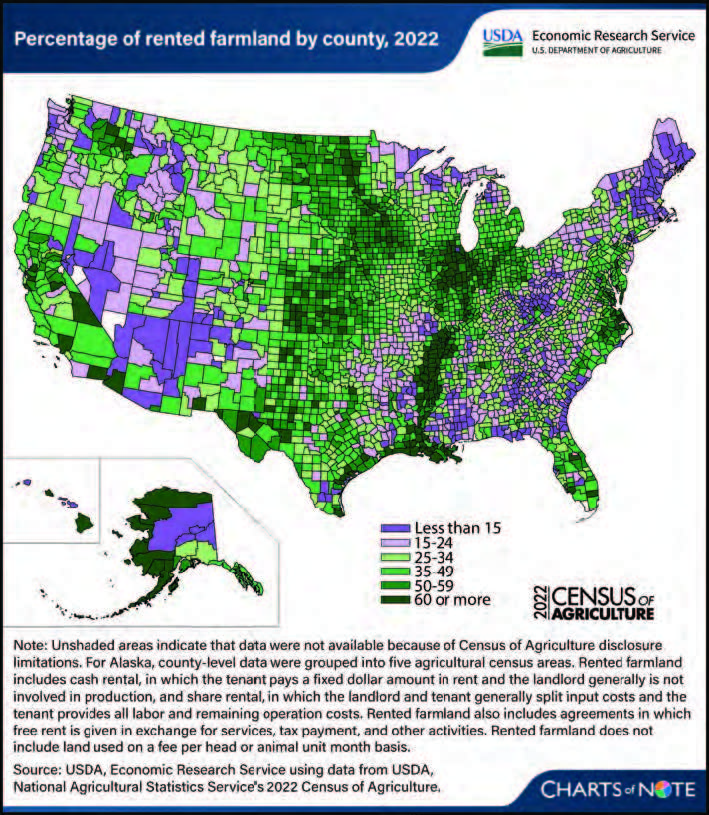Outdoor America 2024 Issue 4
Imagine you are driving and see a farmer out in a field. Perhaps they are planting in the spring or harvesting in the fall. In 39 percent of cases nationwide, you see a farmer who is renting the land, not the landowner. Now let’s say you’re in the mid-Atlantic or the corn belt (which includes Illinois, Indiana and Iowa among other states). The chances could be more than 60 percent that the farmer is renting the land from someone else, known as a non-operator landowner.
The exact dynamics of renting farmland can vary. In some cases, a farmer will “cash rent” land based on a handshake or lease. In others, the farmer and landowner will enter into a crop share arrangement that includes shared costs and returns between both parties. Similarly, the reasons someone might own farmland, but not farm it, are diverse. Some landowners may have inherited a farm from a family member. Others may have purchased it as an investment.
Against this background of different owner-renter relationships, there is an urgent need to deploy more agricultural conservation practices across the landscape. Our soils are eroding and degrading at a rate that puts us on track for another Dust Bowl. More widespread conservation practices on farms could meaningfully reduce water pollution stemming from agricultural runoff that jeopardizes human health. Habitat loss threatens the future of many types of wildlife and birds.
In this context, non-operator landowners are an important group to engage. They may know less about the day-to-day farming operations. But they have a vested interest in the vitality of their land—and by extension, their soil’s health, resource conservation and other factors. Action by the landowner, in coordination with the person farming, has real potential to spur change.
 In many regions of the country, significant portions of farmland are rented. The League is engaging these landowners in discussions about conservation.
In many regions of the country, significant portions of farmland are rented. The League is engaging these landowners in discussions about conservation.
League program engages non-operator landowners
With these dynamics in mind, this fall the Izaak Walton League launched a new pilot project to share information with non-operator landowners about conservation, soil health and opportunities to implement beneficial practices on their land. Others in the League have also prioritized outreach to these landowners because they can play critical roles in scaling up conservation on the ground.
The project was titled the Illinois Landowner Conservation Series and our target area included five counties in east-central Illinois: Christian, Macon, Moultrie, Piatt and Shelby. In this part of the country, more than 70 percent of farmland is rented, and local agriculture is dominated by corn, soybeans and some livestock.
Around 30 landowners were involved in the series. Together, they own and have decision-making power on more than 7,300 acres. Through a series of six workshops and events, we helped participants learn more about:
- the array of conservation practices they might consider
- the basics of soil health
- water quality and the Illinois Nutrient Loss Reduction Strategy
- incentives available to help them start beneficial practices
- how to work with their farmers to prioritize conservation
Throughout the series, we brought in numerous experts and partner organizations including University of Illinois Extension, American Farmland Trust, the Illinois Sustainable Agriculture Partnership, the U.S. Department of Agriculture’s Natural Resources Conservation Service (USDA-NRCS) and the City of Decatur, Illinois.
We also hosted a panel of landowners who are farther along in their conservation journeys to tell their stories and answer questions from participants.
Program sparks interest in conservation options
Upon the project’s conclusion, the landowners who participated were interested in next steps. Some of them plan to seek more information about USDA programs that will help them deploy conservation practices.
Others shared they will be scheduling a time to visit with their tenant farmer to discuss potential next steps. In a follow-up survey, 86 percent told us they were interested in additional information and programming on conservation.
The League’s national staff was encouraged by these efforts in Illinois. For many years, our Agriculture Program has largely been focused on federal policy advocacy. That work is critical to maintain, as we are a leading voice on farm policy and we can help to shape the system as a whole. When we secure a win in the federal policy realm, it is often a win that will impact all 50 states and territories.
Still, we also know the value of driving conservation adoption closer to the ground, closer to the soil. We designed the Illinois Landowner Conservation Series as a proof of concept. Now, with an encouraging first run under our belt, we can analyze how it went and potential next steps for similar work.
How to learn more
Reaching our nation’s farmland owners is exciting and complex. If you are interested in learning more about our work with landowners, or have ideas as we move forward, please sign up for our Soil Matters newsletter or reach out to me at khansen@iwla.org.
Top photo: Participants in the landowner conservation program hear about soil health from Jim Isermann of the Illinois Sustainable Agriculture Partnership at the series kickoff in Decatur, Illinois. Credit: Kate Hansen.